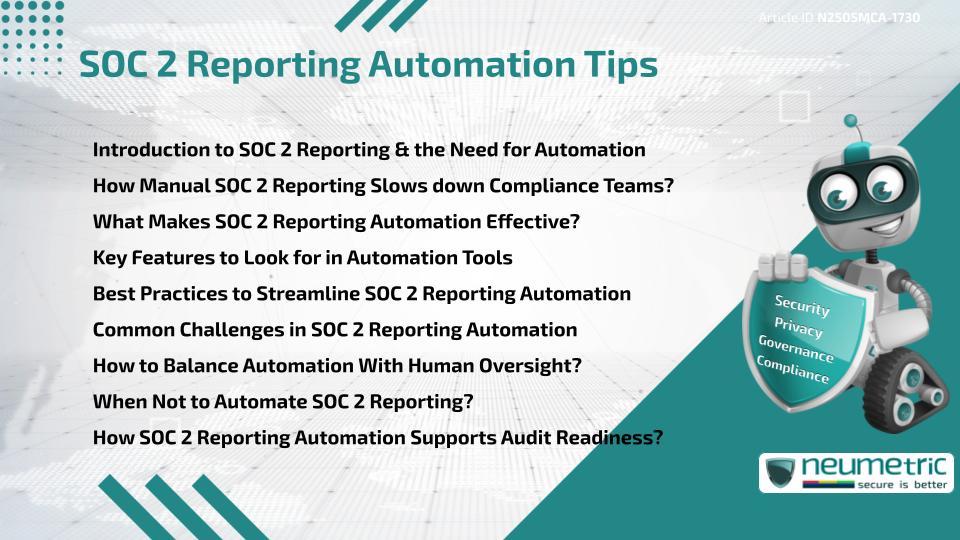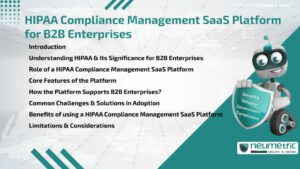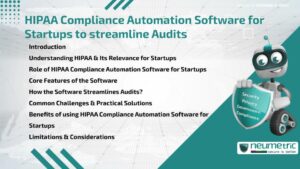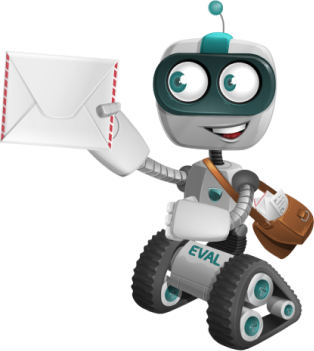Table of Contents
ToggleIntroduction to SOC 2 Reporting & the Need for Automation
SOC 2 Compliance has become a Standard requirement for many B2B SaaS companies, especially those handling Customer Data. It is based on five Trust Services Criteria: Security, Availability, Processing Integrity, Confidentiality & Privacy. The reporting aspect of SOC 2 focuses on documenting controls & evidence of implementation to satisfy Audit requirements.
Manual reporting is time-consuming, error-prone & often difficult to scale. This is where SOC 2 reporting automation tips come in. By leveraging automation, businesses can streamline their Compliance efforts, reduce the Risk of oversight & stay Audit-ready with minimal manual intervention.
How Manual SOC 2 Reporting Slows down Compliance Teams?
Manual SOC 2 reporting relies on spreadsheets, screenshots & email chains to collect & store evidence. This process introduces Risks:
- Inconsistencies in documentation
- Delays in preparing Audit-ready reports
- High resource dependency on Compliance personnel
- Difficulty tracking changes over time
Compliance teams can spend weeks chasing down data or duplicating work. Over time, this creates inefficiencies that automation is designed to eliminate.
What Makes SOC 2 Reporting Automation Effective?
Automation in SOC 2 reporting is not just about replacing manual effort. It is about making the reporting process continuous, scalable & less prone to human error.
Effective automation tools help by:
- Continuously monitoring control environments
- Collecting evidence in real time
- Creating Audit logs automatically
- Alerting Stakeholders of Compliance deviations
These tools often integrate with cloud providers, HR systems & ticketing platforms to pull relevant data without requiring repetitive manual inputs.
Key Features to Look for in Automation Tools
Choosing the right automation platform involves looking beyond flashy dashboards. Here are essential features to look for:
- Pre-mapped controls for SOC 2 Trust Services Criteria
- Integrations with cloud services, identity providers & productivity tools
- Evidence versioning & historical logs
- Audit trail visibility for External Auditors
- Custom policy templates aligned with your Controls
These features support Audit-readiness while reducing the back-and-forth with auditors.
A helpful resource for evaluating such features is the Cloud Security Alliance’s STAR Program.
Best Practices to Streamline SOC 2 Reporting Automation
To get the most value from automation, organisations should follow a structured approach. Here are some Best Practices:
- Map your existing controls before implementing any tool
- Automate only what is standardised—not every custom process
- Set periodic internal reviews of automated evidence
- Train relevant Stakeholders on how the system works
- Ensure Data Privacy rules are being followed in automated Evidence Collection
These tips ensure that automation complements rather than complicates your Compliance efforts.
Common Challenges in SOC 2 Reporting Automation
Despite its advantages, automation introduces challenges:
- False sense of security: Automation might give the illusion that all controls are working perfectly
- Misconfigurations: Poor setup can lead to wrong or missing evidence
- Over-reliance on tools: Critical thinking & human judgment are still required
- Vendor lock-in: Some tools make it hard to switch once implemented
Recognising these issues early helps avoid bigger problems during Audits.
How to Balance Automation With Human Oversight?
Even the most advanced SOC 2 reporting automation tips acknowledge the importance of human oversight. Here is how to strike a balance:
- Use automation for data collection & formatting
- Keep control assessments & Risk analysis in the hands of experts
- Validate evidence quality with manual spot-checks
- Review alerts & reports regularly for anomalies
Automation should enhance decision-making, not replace it. Keeping humans in the loop ensures accountability.
When Not to Automate SOC 2 Reporting?
Automation is not always the answer. In certain cases, manual processes are better suited:
- New or evolving controls that require contextual judgment
- One-time assessments or exceptions
- Controls based on company culture or policy narratives
Blindly automating everything can lead to Compliance gaps. Use judgment to decide where automation adds value & where it does not.
How SOC 2 Reporting Automation Supports Audit Readiness?
Auditors need consistent, accurate & timestamped data. With automation:
- Evidence is collected continuously, avoiding last-minute rushes
- All activity is logged & versioned for traceability
- Reports are structured around Trust Services Criteria
- Gaps or failures are flagged automatically, allowing early fixes
This level of preparedness drastically reduces stress & improves success during formal audits.
Takeaways
- Manual SOC 2 reporting introduces delays & inconsistencies
- Automation offers real-time evidence, integrations & scalability
- Choose tools with strong control mapping & evidence tracking
- Balance automation with regular human review
- Not every process should be automated—use discretion
- Automation leads to better Audit outcomes & long-term Compliance sustainability
FAQ
What are some common tools used for SOC 2 reporting automation?
Tools often include cloud Compliance platforms that integrate with AWS, GCP, Azure, GitHub & HR systems to collect Audit-ready evidence.
Can automation completely replace manual SOC 2 reporting?
No, human oversight is still needed for decision-making, interpreting control effectiveness & handling edge cases.
How frequently should automated SOC 2 reports be reviewed?
Automated reports should be reviewed at least quarterly, though high-Risk controls may require monthly checks.
What is the biggest Risk of relying too much on automation?
The biggest Risk is a false sense of security—believing everything is in Compliance just because the tool says so.
Are there any controls that should never be automated?
Yes, controls based on policy interpretation or cultural behaviour should generally remain manual.
Do automation tools help during SOC 2 Type 2 audits?
Yes, they are particularly useful for Type 2 Audits, which require proof of control effectiveness over a period of time.
Is it hard to switch automation vendors later?
Some tools make migration difficult due to proprietary formats or limited export options. Consider flexibility when choosing a tool.
Can small companies benefit from SOC 2 reporting automation tips?
Absolutely. Automation helps small teams scale their Compliance efforts without hiring dedicated Audit staff.
Need help?
Neumetric provides organisations the necessary help to achieve their Cybersecurity, Compliance, Governance, Privacy, Certifications & Pentesting goals.
Organisations & Businesses, specifically those which provide SaaS & AI Solutions, usually need a Cybersecurity Partner for meeting & maintaining the ongoing Security & Privacy needs & requirements of their Clients & Customers.
SOC 2, ISO 27001, ISO 42001, NIST, HIPAA, HECVAT, EU GDPR are some of the Frameworks that are served by Fusion – a centralised, automated, AI-enabled SaaS Solution created & managed by Neumetric.
Reach out to us!





